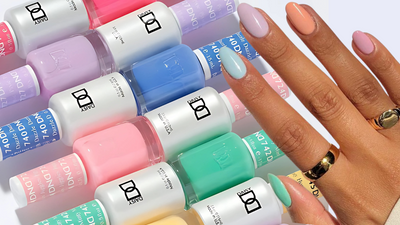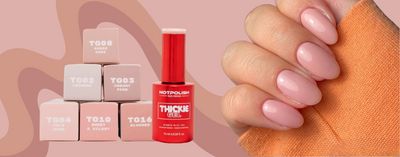
Cuticles protect our nails from bacteria and infections. Without proper care, we risk contaminating our nail beds. Fortunately, cuticle care is easy to establish in daily routines and your salon’s practices. Protect your customers’ nails by learning how to keep your clients’ cuticles healthy. This valuable guide offers tips and helpful advice!
Why Is Cuticle Care Important?
Cuticles contribute to overall nail health. Your cuticles are at the base of your nails where the skin and nail meet. You’ll see a white crescent shape—that’s the lunula. Your cuticle is the piece of skin that overlaps the nail and touches the lunula. Cuticles protect tissues that grow new cells to build and strengthen nails.
As nails constantly grow, taking care of your cuticles is important because they contribute to long, strong, and healthy nails. If you neglect them, you risk fungal infections and bacteria impeding proper nail growth.
As a nail technician, taking care of your clients’ cuticles is just as important as taking care of your own! You want to prevent infections and ensure a healthy base for manicures.
What Causes Cuticle Damage?
Without proper care, people experience cuticle damage. The biggest contributor to damage is picking or biting nails. Picking at the skin surrounding nails also leads to damage.
Weather and other harsh exposures can also negatively impact cuticle health. For example, excessive cold or sun exposure makes cuticles dry and chapped. Additionally, chlorine and salty or soapy water make cuticles chapped and susceptible to cracking.
Without treatment, damage worsens and becomes more than just dry skin around the nails. It leads to infections that require antifungal medications. In severe cases, doctors need to perform a medical procedure to drain infections.
Signs of Infection
Although people can treat cuticle damage, it’s important to recognize the signs of infection. Paronychia is an infection that develops when bacteria enter broken skin around the cuticle. Symptoms of paronychia include the following:
- Redness around the nail
- Nail detachment
- Change in nail shape, texture, or color
- Tenderness
- Pus-filled blisters
Things Nail Technicians Should Do
Cuticle infections aren’t fun. They’re painful and irritate the skin. Fortunately, you can step in and prevent this problem entirely. Keep your clients’ cuticles healthy by following the advice below.
Always Use Clean Manicure Instruments
Using clean manicure instruments is a required salon practice that prevents the spread of germs. As mentioned, paronychia develops when bacteria enter broken skin. Germs from dirty tools can lead to infections. This harmful to clients and bad for business. After all, no one wants to visit a salon known for bacteria outbreaks. So make sure to disinfect and sterilize tools before servicing clients.
Only Cut Cuticles When Necessary
Only cut your clients’ cuticles when absolutely necessary. In general, cutting cuticles makes them wider and more vulnerable to germs and diseases. As a nail tech, you understand the anatomy of nails and can trim cuticles without creating problems.
When you trim cuticles, use a metal pusher to push the cuticles toward the end of the nails. Then, soften the skin with warm water or cuticle remover. Lastly, only trim the dead skin. You don’t want to cut healthy tissue.
Hydrate Cuticles During Manicures
We can’t stress the importance of hydration enough! During manicures, moisturize cuticles with hand creams, lotions, or ointments. Many dermatologists recommend petroleum jelly—Vaseline—as an inexpensive yet effective way to care for cuticles. It’s also best to keep cuticle oil on hand because it has a blend of vitamins and oils that support nail health.
Be Gentle With Your Clients’ Nails
Besides paronychia, people develop problems due to aggressive nail technicians. Over-manipulation causes problems such as sore or red nails. Be gentle with clients’ nails and avoid pushing cuticles back too roughly. If you notice redness or become too vigorous, stop manipulating the client’s cuticles. Take a quick break to massage the client’s hands, then proceed gently.
Consider Hot Wax Treatments
Hot wax treatments are popular in nail salons because they’re relaxing and deeply nourishing. Heat paraffin wax and allow your client to dip their hands in the warm liquid. Then apply plastic gloves to seal in the heat. Let the gloves stay on your client’s hands for 10 to 15 minutes. The wax will soften the client’s hands and cuticles and moisturize their skin.
Advice To Offer Your Clients
In the nail salon, you take care of your clients’ nails. However, when they leave the shop, they’re responsible for daily maintenance. For continuous growth and support, offer cuticle care advice to your clients. Here are the best tips to tell your clients:
- Avoid picking your cuticles. If you have a hangnail, soften the nail with warm water and use tweezers to remove the excess skin.
- Don’t bite your nails. Saliva enzymes break down skin, making it easier for bacteria to enter nail beds.
- Prevent dry cuticles by avoiding harsh soaps, sanitizers, and polish removers.
- If you experience signs of infections, seek medical care.
- Apply cuticle oil twice a day or when cuticles are visibly dry.
- Cold weather causes dry cuticles. Remember to protect your hands with gloves or mittens during chilly days.
- Frequently trim nails to prevent the spread of germs and infections. Additionally, file the nails to smooth out rough edges.
The Best Cuticle Treatments
Moisturizing cuticles is a key part of maintaining healthy nails. Moisturizing treatments support growth and improve the circulation of cells around cuticles. For daily hydration, there are different oils and treatments available. Here are the best cuticle treatments to consider:
- Geranium essential oil—This oil has antifungal properties with a strong antiseptic. It rejuvenates skin cells and supports healing. Geranium also minimizes scar tissue. It’s a great everyday treatment for cuticles.
- Coconut oil—An inexpensive cuticle treatment is coconut oil. The saturated fat strengthens nail beds and is soothing for the skin. A hand massage with coconut oil moisturizes skin and helps cuticles.
- Biotin cuticle salve—Biotin prevents brittle nails, and it strengthens cuticles. A biotin salve contains biotin, argon oil, coconut oil, and vitamin E. You can DIY this salve or purchase it from a store.
- Petroleum jelly (Vaseline)—For dry or cracked cuticles, Vaseline is ideal. The soothing and healing jelly penetrates the skin to nourish cuticles. It’s mild and safe for daily use.
- Cuticle cream—Most creams use natural oils, waxes, and moisture-binding agents to create an ointment that hydrates cuticles. It’s safe to use these creams daily.
- Tea tree essential oil—This oil has antifungal and antibacterial properties that prevent infections. Please note that this essential oil is potent, so mixing the liquid with a carrier oil—such as coconut oil—is best.
Grab all the salon essentials in one place. Nail Company Wholesale Supply carries CND dip powder, among other fantastic products. We have products for cuticles, trendy nail decals, and salon equipment. If you have any questions, don’t hesitate to contact us today!




